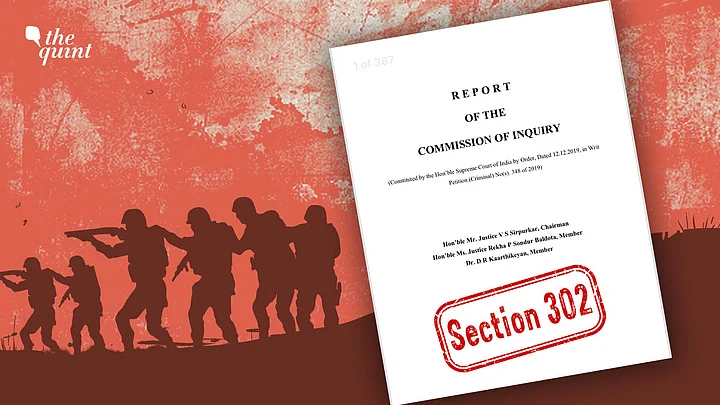On 6 December 2019, bodies of four youngsters accused of raping and murdering Disha, a 26-year-old veterinarian, were found in a field at Chattanpally village near Hyderabad. On Friday, 20 May, the Supreme Court appointed Justice VS Sirpurkar Commission found that 10 Hyderabad police officials are to be tried for murder in the ‘encounter killing case.’
In the commission’s detailed report, which was submitted before the Supreme Court on Friday, it is observed, “the actions of the police officers in deliberately firing at the deceased suspects, is not justified…”
The commission further observed, “In our considered opinion, the accused were deliberately fired upon with an intent to cause their death and with the knowledge that the firing would invariably result in the death of the deceased suspects.”
The Hyderabad police has been maintaining that the four accused – C Chennakesavulu, Jollu Shiva, Jollu Naveen and Mohammed Arif – were killed when they ‘attacked police officials’ and tried to flee the spot to which they were taken for an ‘evidence collection drive.’ The police’s claim has been that the accused threw soil to incapacitate police officials who were accompanying them, snatched two weapons and fired at the police, even as they ran to escape from the fallow field.
‘Common Intension to Cause Death’: Police Accused of Murder and Tampering Evidence
A total of ten police officers had accompanied the accused to Chettanpally, from where they were expected to recover material objects connected to Disha’s murder. According to the commission, which cross examined witnesses and evidence in October-November 2021 – the deceased have not committed the offence claimed by the police.
The commission observed:
“After considering the entire material on record, we conclude that the deceased have not committed any offence in connection with the incident on 6 December 2019, like snatching the weapons, attempt to escape from the custody, assaulting and firing at the police party.”
This being the case, the commission states that the police officers who fired at the accused cannot defend their action on the grounds of ‘private defence,’ or self defence. The commission further terms the police officers’ action as ‘deliberate firing.’
If either by “acts or omissions” the the police officials, who had fired at the accused, have “failed to fulfil their responsibility,” their “common intention to cause the deaths of the deceased suspects is established,” the commission observed.
‘Falsified Evidence and No Private Defence, Good Faith’
The police officials also falsified record, after the deaths of the deceased, the commission observed.
Accusing the police of negligence, the commission wrote, “…Not only did they act in furtherance of common intention to give false information in order to screen the offenders but also that, they all acted with the common intention to cause the deaths of the four deceased suspects.”
According to the commission, all ten police officials are liable to be tried under section 302 of IPC (murder) and section 201 of IPC (attempt to tamper evidence), as the commission has found that acts committed by them were directed towards the “common intention to kill the deceased persons.”
In this case, it is important to note that the commission has not given the three police officers who allegedly shot at the accused, protection under section 76 of IPC and exception 3 to section 300 of IPC. These sections allow the police officials to fire during dire circumstances under “good faith.”
For section 76 to be applicable, the official has to be bound by law and should have done the alleged act in “good faith.” For example, an officer of the law firing a riotous mob on the command of his superior officer has not committed any offense as per the section.
For exception 3 of section 300 of IPC to be applicable, the act should have been committed lawfully for ‘private defence.’ As the commission found that the deceased did not fire upon the police officials, this exception was not granted to them.
The police officials who are “liable to trial” for murder are: V Surender, K Narasimha Reddy, Shaik Lal Madhar, Mohammed Sirajuddin, Kocherla Ravi, K Venkateshwarulu, S Arvind Goud, D Janakiram, R Balu Rathod, and D Srikanth.
But why did the commission not believe the police’s version? The Quint had earlier reported that it was apparent that the state police’s case was being torn into during the hearing.
From the 'safe house' in which the four accused were kept till they were taken to Chattanpally to the alleged attack on police officers at the spot, and inquest done after the death of the accused, the commission has found that the police's version is riddled with discrepancies.
But most importantly, the commission has found that there was no explicit need to take the accused to the 'encounter' spot in the first place as there was no second confession in which they mentioned the spot. The police's case, in most parts, is "unbelievable." the commission has maintained.
